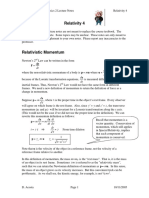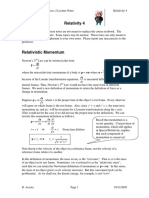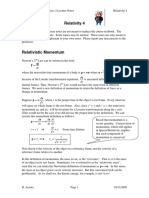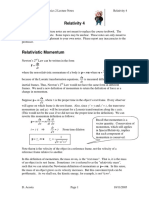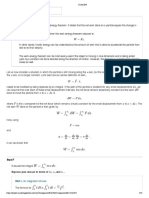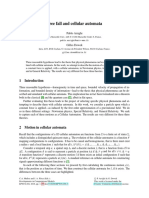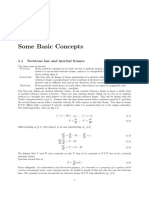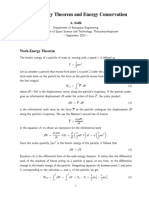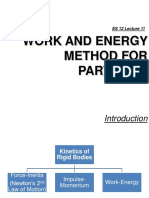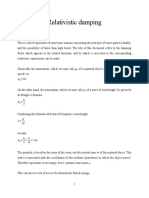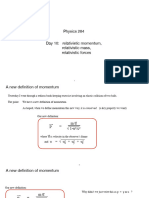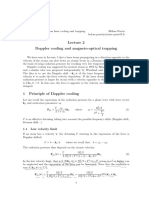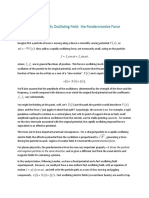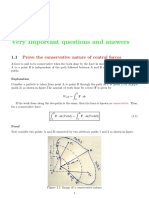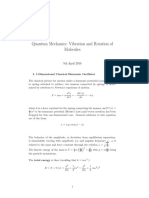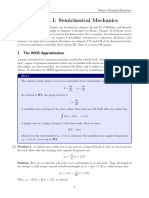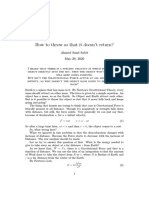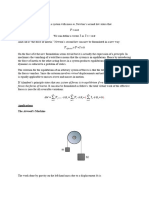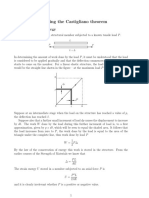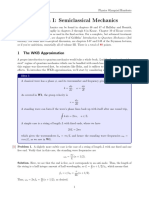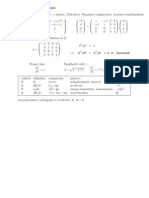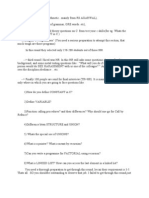Relativity4 PDF
Relativity4 PDF
Uploaded by
Buddhadeb RoyCopyright:
Available Formats
Relativity4 PDF
Relativity4 PDF
Uploaded by
Buddhadeb RoyOriginal Title
Copyright
Available Formats
Share this document
Did you find this document useful?
Is this content inappropriate?
Copyright:
Available Formats
Relativity4 PDF
Relativity4 PDF
Uploaded by
Buddhadeb RoyCopyright:
Available Formats
PHY2061 Enriched Physics 2 Lecture Notes Relativity 4
Relativity 4
Disclaimer: These lecture notes are not meant to replace the course textbook. The
content may be incomplete. Some topics may be unclear. These notes are only meant to
be a study aid and a supplement to your own notes. Please report any inaccuracies to the
professor.
Relativistic Momentum
Newton’s 2nd Law can be written in the form
dp
F=
dt
dx
where the non-relativistic momentum of a body is p = mu where u = . However,
dt
dx
because of the Lorentz transformation equations, is measured differently in different
dt
inertial frames. Thus, Newton’s 2nd Law would not have the same form in different
frames. We need a new definition of momentum to retain the definition of force as a
change in momentum.
dx
Suppose p = m , where τ is the proper time in the object’s rest frame. Every observer
dτ
will agree on which frame is the rest frame. Also, since y ′ = y and z ′ = z , the transverse
momentum (py and pz) will be invariant for a Lorentz transformation along the x axis.
(This would not be the case if we did not use the proper time in the definition). We can
rewrite this momentum definition as follows:
dx dx dt Recall that momentum is a
p=m =m
dτ dt dτ vector quantity. Conservation of
dt momentum, which still applies
t =γτ ⇒ =γ From time dilation in Special Relativity, implies
dτ
that each component of
1 momentum is conserved.
p = γu m u γu =
1− u / c
2 2
Note that u is the velocity of the object in a reference frame, not the velocity of a
reference frame relative to another.
In this definition of momentum, the mass m=m0 is the “rest mass”. That is, it is the mass
of an object in its rest frame. Sometimes γ m is referred to as the “relativistic mass”,
such that we can retain the Newtonian definition of momentum as p = mu . In this sense,
the mass of an object grows as its velocity increases. But this convenient trick can be
problematic. As we shall see, the kinetic energy, for example, is not ½ mv2.
D. Acosta Page 1 10/11/2005
PHY2061 Enriched Physics 2 Lecture Notes Relativity 4
Relativistic Force
With the previous relativistic definition for momentum, we can retain the usual definition
for force:
dp d ⎛ dx ⎞ d dx 1
F= = ⎜ m ⎟ = ( γ u mu ) where u = and γ u =
dt dt ⎝ dτ ⎠ dt dt 1 − u 2 / c2
It is useful to consider how force transforms under a Lorentz Transformation:
y S y' S'
v u⊥′
x x'
z z'
According to the addition of velocity formulae, the transformation of the velocity
perpendicular to the direction of the Lorentz Transformation is:
u ⊥′ 1
u⊥ = where γ v =
(
γ v 1 + vu x′ / c 2 ) 1 − v2 / c2
So for the perpendicular force, which can be written as:
d dx d
F⊥ = m = m u⊥
dt dτ dτ
it transforms as:
d u ⊥′ 1 du ′
F⊥ = m = m ⊥
(
dτ γ 1 + vu ′ / c 2
v x ) (
γ v 1 + vu x′ / c 2 dτ
)
F⊥′
F⊥ =
(
γ v 1 + vu x′ / c 2 )
where we assume no acceleration in the direction parallel to the transformation
D. Acosta Page 2 10/11/2005
PHY2061 Enriched Physics 2 Lecture Notes Relativity 4
Relativistic Energy
Now work is defined as force applied over a distance. It corresponds to the expended
energy to accelerate a body. If the force and path are constant,
W = F⋅d
More generally, if the force and path vary, then a line integral must be performed from
initial position 1 to final position 2.
W12 = z 1
2
F ⋅ ds
The work applied to a body translates to a change in the kinetic energy since energy must
be conserved. If we assume that the body is initially at rest, then the final kinetic energy
is equal to the work expended:
2
W=K=
d
dt z a f
γ mu ⋅ u dt where we have used ds = u dt
ds
z
K = m dt
d
dt
γu ⋅ u a f 1
u
K=m z0
γU
u d aγ uf
Integrate by parts:
K = γ mU 2 − m γ u du z U
= γ mU 2 − m z
0
U u du
1 − u2 / c2
You can check this
integral by differentiation
= γ mU 2 + mc 2 1 − u 2 / c 2 U
0
= γ mU 2 + mc 2 1 − U 2 / c 2 − mc 2
c
= γ mU 2 + mc 2 1 − U 2 / c 2 − mc 2 h
Thus, we get for the relativistic kinetic energy:
K = γ mc 2 − mc 2 = γ − 1 mc 2 a f
This final expression for the kinetic energy looks like nothing like the non-relativistic
1
equation K = mu 2 . However, if we consider velocities much less than the speed of
2
light, we can see the correspondence:
D. Acosta Page 3 10/11/2005
PHY2061 Enriched Physics 2 Lecture Notes Relativity 4
c
γ = 1 − u2 / c2 h 1
− 1/ 2
≈ 1 + u 2 / c 2 +" using the binomial expansion
2
a f
2
1u 1
⇒ K = γ − 1 mc 2 ≈ 2
mc 2 = mu 2 for u << c
2c 2
So at low velocities there is no difference between the definition of kinetic energy in
Special Relativity from that in Newtonian Mechanics.
Now let’s consider the opposite limit when the velocity approaches the speed of light. In
that case, the kinetic energy becomes infinite as the relativistic factor γ goes to infinity.
This is another way of saying that objects cannot exceed the speed of light, because it
would take an infinite amount of energy.
Now let’s rewrite the equation involving the kinetic energy:
E ≡ γmc 2 = K + mc 2
This equation has the form of kinetic energy plus potential energy equals total energy.
What is the potential energy? It is the term:
E0 = mc 2
which we refer to as the rest energy. As you know, this is Einstein’s famous equation
that tells us that mass is another form of energy. Mass can be converted into energy and
vice versa. How much energy? Let’s see:
Example: Suppose that a 1 kg mass moves at a velocity u = 1 m/s. The kinetic energy is
½ m u2 = ½ J. (We can use the non-relativistic equation because the velocity is much
much smaller than the speed of light.) The rest mass energy is mc 2 = 9.0 × 1016 J. Clearly
there is a tremendous amount of energy in 1 kg of mass. That is why nuclear weapons
have the power that they do, because they convert a significant amount of mass into
energy.
Conservation of Energy:
We have learned in earlier physics courses that kinetic energy does not have to be
conserved in an inelastic collision. Likewise, mass does not have to be conserved since it
can be converted into energy. However, the total energy (kinetic, rest mass, and all other
potential energy forms) is always conserved in Special Relativity. Momentum and
energy are conserved for both elastic and inelastic collisions when the relativistic
definitions are used.
D. Acosta Page 4 10/11/2005
PHY2061 Enriched Physics 2 Lecture Notes Relativity 4
Relationship between Energy and Momentum
Using the Newtonian definitions of energy and momentum,
1
E = mu 2 and p = mu , we can write:
2
p2
E=
2m
Now consider the relativistic definitions:
E = γmc 2
p = γmu
p2 = γ 2 m2u2
p2c2 = γ 2 m 2u2c 2 = γ 2 m 2c 4
u2 FG 1
= γ 2 m2c4 1 − 2
IJ
c 2
H γ K
p2c2 = γ 2 m2c 4 − m2c 4
But E = γmc 2
So p 2 c 2 = E 2 − m 2 c 4
Thus the equivalent relationship between energy and momentum in Relativity is:
E 2 = p 2 c 2 + m2 c 4 or equivalently m2 c 4 = E 2 − p 2 c 2
This is another example of Lorentz Invariance. No matter what inertial frame is used to
compute the energy and momentum, E 2 − p 2 c 2 always given the rest energy of the
object. Energy and momentum take the role of time and space in the other Lorentz
invariant quantity ∆s . In fact, we refer to (t, x, y, z ) and ( E, px , py , pz ) as four-vectors,
and the “lengths” of these vectors are these Lorentz-invariant expressions we derived.
Particles without mass are a special case
⇒ E = pc
E and pc can also be written: E = γmc 2 and pc = γ muc .
The only way we can reconcile these last two definitions with E = pc is to set the
velocity to c. Massless particles must travel at the speed of light.
As we will learn, light itself is composed of particles (photons). To travel at the speed of
light, these particles must be massless.
D. Acosta Page 5 10/11/2005
PHY2061 Enriched Physics 2 Lecture Notes Relativity 4
The Electron-Volt Energy Unit
a f
The Lorentz force law is F = q E + v × B , where E is the electric field and B is the
magnetic field. The work done to move a charged particle in an electric field only is:
2 2
W12 = ∫ F ⋅ ds = q ∫ E ⋅ ds
1 1
= q (V2 − V1 )
The electric potential is φ (such that the electric field E = −∇V ). We can summarize the
work done by;
W = q∆V ∆V = potential difference
Consider the work done to move an electron across a potential difference of 1 Volt?
c ha f
W = −1.6022 × 10 −19 C −1 V = 1.6022 × 10 −19 J
e-- q=-1.6022 x 10-19 C
This is a very small unit! We define it as a new unit 1V
of energy, the electron-volt:
1 eV = 1.6022 × 10 −19 J
Example: Express the electron rest mass energy in this new unit:
c hc
E0 = me c 2 = 9.11 × 10 −31 kg 3.0 × 10 8 m / s h 1.60221 eV
2
× 10
J -19
E0 = 511,000 eV (or 511 keV, 0.511 MeV, 0.000511 GeV)
We also can define new units for mass and momentum. For example, the mass of the
electron can be expressed me = 0.511 MeV / c 2 . In other words, if you multiply the mass
by c2, you get the rest energy in electron-volts.
Similarly, we know that pc has units of energy, so momentum can be expressed in units
like MeV / c. In other words, if you multiply by c, you get an energy in electron-volts.
D. Acosta Page 6 10/11/2005
PHY2061 Enriched Physics 2 Lecture Notes Relativity 4
Invariant Mass
We can now apply the relativistic definitions of energy and momentum to
calculations of particle collisions. In particular, we can compute the rest mass of a
particle formed when two particles annihilate into pure energy and then form a new
particle.
Example: An electron and a positron (an anti-electron) annihilate with equal and
opposite momentum: p = 155 . GeV / c . (Note the new momentum unit). The collision
produces a new particle called the J/ψ in the following reaction: e − + e + → J / ψ . What is
the mass of this new particle?
We need to compute the invariant mass of the electron-positron initial state to
determine the rest mass of the new particle:
Mc 2 = Etot
2
− ptot
2 2
c where Etot and ptot are the total energy and momentum
ptot = p1 + p2 = 155
. GeV / c − 155
. GeV / c = 0 by conservation of momentum
Etot = E1 + E2 by conservation of energy
E1 = p12 c 2 + m2 c 4 = b155
. GeVg + b0.000511 GeVg
2 2
≈ 155
. GeV
E1 = E2 because the magnitude of the momentum (and mass) is the same
⇒ Mc 2 = Etot = 155
. + 155
. GeV = 31
. GeV
The J/ψ particle has a mass of 3.1 GeV/c. Note that we have made extensive use of the
new Lorentz-invariant quantity involving energy and momentum
D. Acosta Page 7 10/11/2005
PHY2061 Enriched Physics 2 Lecture Notes Relativity 4
Binding Energy
As we have learned, mass is a form of potential energy. It can be converted into
energy, or energy can be converted into mass. Because of this, mass does not have to be
conserved in reactions. If you throw two balls at each other and they stick together (an
inelastic collision), the resulting mass is not necessarily the sum of the individual masses
of the two balls.
This surprising result makes sense when we consider that mass is just another
form of potential energy. When two balls stick together, there must be some attractive
force holding the composite system together. In the case of the hydrogen atom, an
electron and proton are bound by an attractive electromagnetic force. To separate the
electron and proton (i.e. ionize hydrogen), one must overcome the attractive force, and
that takes energy. In other words, the particles have larger electromagnetic potential
energy when separated than together. This potential energy is:
−e2
V=
4πε 0r
which increases as the separation distance r increases.
Where does this increase in energy go, since we know the total energy must be
conserved? It goes into the rest mass energies of the electron and proton in the case of
hydrogen. Another way of putting it is that the hydrogen atom has a mass that is less
than the sum of the separate masses of the electron and proton. The difference in the rest
mass energies of the separate objects from the combined system is called the binding
energy:
m b g b
BE = M separate − M bound gr c 2
In the case of hydrogen, the binding energy is 13.6 eV; that is, hydrogen has a mass that
is 13.6 eV less than the sum of the masses of the electron and proton.
Let’s consider another example. The deuteron is a bound system of a neutron and
a proton. The binding energy is given by:
o b g b g c ht c
BE = M n + M p − M 2 H 2
BE = m939.57 MeV / c + 938.28 MeV / c
2 2
− 1875.63 MeV / c 2 r
BE = 2.22 MeV
Clearly nuclear binding energies are much larger than atomic binding energies! We will
explore this more when we study nuclear physics toward the end of this course.
D. Acosta Page 8 10/11/2005
PHY2061 Enriched Physics 2 Lecture Notes Relativity 4
Reaction Energy
Closely related to binding energy is the concept of reaction energy. Not all
composite systems have a mass less than the sum of its constituent masses, and some
fundamental particles spontaneously decay into particles whose combined mass is less
than that of the parent. In these cases, energy is released in the decay or reaction because
of the difference in rest mass energies. We define this reaction energy as:
m b g b
Q = M initial products − M final products c2 gr
As you can see, it is just the negative of the binding energy. If Q is positive, we say that
the reaction or decay is exothermic; that is, it releases energy. If Q is negative, the
reaction or decay is endothermic; it takes energy to make it happen.
Example: Consider the spontaneous decay of a neutron: n → p + e − + ν e . We can
calculate the energy released in this decay by taking the difference in mass of the left-
hand side from the right-hand side. The neutrino ( ν e ) will be discussed later in the
nuclear and particle physics sections; what is relevant here is that its mass is essentially
zero.
o b g b g c ht
Q = M n − M p − M e − c2
Q = m939.57 MeV / c − 938.28 MeV / c
2 2
r
− 0.511 MeV / c 2 c 2
Q = 0.78 MeV
D. Acosta Page 9 10/11/2005
You might also like
- Percentage, Ratio Strength, and Other Expressions of Concentration Lecture (6)Document36 pagesPercentage, Ratio Strength, and Other Expressions of Concentration Lecture (6)Ahmed Hassan Mina HamadNo ratings yet
- JTL Book Common Plumbing ProcessesDocument40 pagesJTL Book Common Plumbing Processesbendeni100% (1)
- Relativity4 PDFDocument9 pagesRelativity4 PDFBuddhadeb RoyNo ratings yet
- Relativity4 2Document9 pagesRelativity4 2Kafka FlippyNo ratings yet
- Relativity4 PDFDocument9 pagesRelativity4 PDFCSharp DevelopersNo ratings yet
- Relativity 4Document9 pagesRelativity 4sudaisshenwari917No ratings yet
- Relativity4 PDFDocument9 pagesRelativity4 PDFSk Suraj SinghNo ratings yet
- Relativity4 PDFDocument9 pagesRelativity4 PDFHarbir Singh ParmarNo ratings yet
- Notes On Analytical MechanicsDocument58 pagesNotes On Analytical Mechanicsrounaqul2020ipadNo ratings yet
- RelativityDocument7 pagesRelativityТеодора ПаскалеваNo ratings yet
- b2 MechanicsDocument9 pagesb2 MechanicsSifei ZhangNo ratings yet
- 02 Newtonian Mechanics AdvancedDocument37 pages02 Newtonian Mechanics AdvancedRithish BarathNo ratings yet
- MP 06Document2 pagesMP 06l Faris lNo ratings yet
- Classical Mechanics Leonard Susskind ClassNotesDocument32 pagesClassical Mechanics Leonard Susskind ClassNotesAltair AngkasaNo ratings yet
- Lecture07 Physics PDFDocument3 pagesLecture07 Physics PDFMuzamil HussainNo ratings yet
- Mechanics NotesDocument32 pagesMechanics NotesroystaggersNo ratings yet
- Lecture4 2Document8 pagesLecture4 2Sabbir HossainNo ratings yet
- Free Fall and Cellular Automata: Pablo ArrighiDocument10 pagesFree Fall and Cellular Automata: Pablo ArrighiO maninho do açoNo ratings yet
- Some Basic Concepts: 1.1 Newtons Law and Inertial FramesDocument16 pagesSome Basic Concepts: 1.1 Newtons Law and Inertial Framestbrackman99No ratings yet
- hw8 PDFDocument44 pageshw8 PDFShaya Nirenberg0% (3)
- Work-Energy Theorem and Energy ConservationDocument5 pagesWork-Energy Theorem and Energy ConservationEmre HpNo ratings yet
- Lecture 13Document33 pagesLecture 13Jarom SaavedraNo ratings yet
- Revision Notes: M1: Velocity and Displacement VectorsDocument3 pagesRevision Notes: M1: Velocity and Displacement VectorsakilNo ratings yet
- Lecture #32 - Summary Muons - An Example of Time Dilation and Length ContractionDocument4 pagesLecture #32 - Summary Muons - An Example of Time Dilation and Length ContractionMargaret OnuNo ratings yet
- 11 Work and Energy For ParticlesDocument28 pages11 Work and Energy For ParticlesNina MabantaNo ratings yet
- The Heat and Wave Equations in 2D and 3DDocument39 pagesThe Heat and Wave Equations in 2D and 3DDavid PatricioNo ratings yet
- Summary GenPhys IDocument11 pagesSummary GenPhys IAnthony David Altamirano De La CruzNo ratings yet
- 0054 Handout 6Document14 pages0054 Handout 6zcaptNo ratings yet
- Chapter 1 Relativistic DynamicsDocument7 pagesChapter 1 Relativistic DynamicseltytanNo ratings yet
- Relativistic DampingDocument18 pagesRelativistic DampingChrisTselentisNo ratings yet
- Physics P2 Cheat SheetDocument33 pagesPhysics P2 Cheat SheetfullnameisitNo ratings yet
- C - fakepathII Applied Physics MaterialDocument158 pagesC - fakepathII Applied Physics Materialkhalilof.090No ratings yet
- General RelativityDocument21 pagesGeneral RelativityAshwin BNo ratings yet
- Nimanamazi 0914Document16 pagesNimanamazi 0914shayanNo ratings yet
- (Deruelle) - Nordström's Scalar Theory of Gravity and The Equivalence PrincipleDocument18 pages(Deruelle) - Nordström's Scalar Theory of Gravity and The Equivalence Principlemasaud rejaliNo ratings yet
- Class 10Document17 pagesClass 10zd2y9sgdtjNo ratings yet
- Laser Cooling of Atoms DopplerDocument14 pagesLaser Cooling of Atoms Doppler林ArthurNo ratings yet
- Uyp 2Document3 pagesUyp 2FATIN NOORNo ratings yet
- 2019 PHY Advanced Mechanics Electromagnetism Nature of Light and From The Universe To The Atom NotesDocument52 pages2019 PHY Advanced Mechanics Electromagnetism Nature of Light and From The Universe To The Atom Notesmariamarsbar17No ratings yet
- CM 21 Ponderomotive ForceDocument4 pagesCM 21 Ponderomotive Forcemarc millisNo ratings yet
- Ns EquationsDocument9 pagesNs EquationsTahok24No ratings yet
- All GeometryDocument8 pagesAll Geometryashpi054No ratings yet
- D2 NotesDocument19 pagesD2 Notessayandatta1No ratings yet
- A Derivation of The Navier-Stokes Equations: Neal ColemanDocument7 pagesA Derivation of The Navier-Stokes Equations: Neal ColemanEmmanuel IgweNo ratings yet
- Electrical Potential: 1 Partial DerivativesDocument8 pagesElectrical Potential: 1 Partial Derivativesmughees_itcompNo ratings yet
- Lecture Notes For Physical Chemistry II Quantum Theory and SpectroscoptyDocument41 pagesLecture Notes For Physical Chemistry II Quantum Theory and Spectroscopty3334333No ratings yet
- Phys 06Document12 pagesPhys 06Random PersonNo ratings yet
- 13 Oscillatoryor Periodic Motion Rev 2Document12 pages13 Oscillatoryor Periodic Motion Rev 2Eslam HashimNo ratings yet
- Very Important Questions and Answers: Prove The Conservative Nature of Central ForcesDocument41 pagesVery Important Questions and Answers: Prove The Conservative Nature of Central Forcessoetece ProjectsNo ratings yet
- 2CH404 Chemical Engineering Thermodynamics ReportDocument3 pages2CH404 Chemical Engineering Thermodynamics ReportZaid MansuriNo ratings yet
- Quantum Mechanics: Vibration and Rotation of Molecules: 5th April 2010Document8 pagesQuantum Mechanics: Vibration and Rotation of Molecules: 5th April 2010Baban BaidyaNo ratings yet
- X1 SolDocument28 pagesX1 SolIndumathiNo ratings yet
- Special Theory of RelativityDocument5 pagesSpecial Theory of RelativityManash SinghaNo ratings yet
- Escape Velocity AgainDocument4 pagesEscape Velocity Againsameer chaharNo ratings yet
- Modeling of Mechanical (Lumped Parameter) Elements: Handout # 1Document17 pagesModeling of Mechanical (Lumped Parameter) Elements: Handout # 1Oliver KrausNo ratings yet
- Basic Physics PDFDocument2 pagesBasic Physics PDFGabriel BettinelliNo ratings yet
- Chem3322 Notes1Document13 pagesChem3322 Notes1Priya RajanNo ratings yet
- D AlambertDocument3 pagesD AlambertStuart GregoryNo ratings yet
- Castigliano TheoremDocument8 pagesCastigliano Theoremsameshni pillayNo ratings yet
- X1Sol Part1Document10 pagesX1Sol Part1Boldie LutwigNo ratings yet
- 4vector PhysDocument7 pages4vector Physhassaedi5263No ratings yet
- Feynman Lectures Simplified 2B: Magnetism & ElectrodynamicsFrom EverandFeynman Lectures Simplified 2B: Magnetism & ElectrodynamicsNo ratings yet
- Static MixersDocument12 pagesStatic MixersCal100% (2)
- Projects For The Unimat Part 2Document95 pagesProjects For The Unimat Part 26KILLER100% (2)
- DFM Module 1Document51 pagesDFM Module 1Orville SutariNo ratings yet
- Cosasco RBS - Rbsa Retriever MaintenanceDocument44 pagesCosasco RBS - Rbsa Retriever MaintenanceSeip SEIPNo ratings yet
- Iot EcuwiringDocument26 pagesIot EcuwiringJavi ChitoNo ratings yet
- Tunnelling and Underground Space Technology: D.V.L. Hunt, D. Nash, C.D.F. RogersDocument12 pagesTunnelling and Underground Space Technology: D.V.L. Hunt, D. Nash, C.D.F. Rogersshadowkev5No ratings yet
- MCX 912 and 913 Parameter Collection FormDocument3 pagesMCX 912 and 913 Parameter Collection FormMahesh KubadeNo ratings yet
- TDS - BBR - ST 720 FINALDocument2 pagesTDS - BBR - ST 720 FINALSANo ratings yet
- Is-460-Part-1-2020 (Wire Cloth Test Sieves)Document16 pagesIs-460-Part-1-2020 (Wire Cloth Test Sieves)Samiran Sen100% (1)
- Susan Newman ResumeDocument2 pagesSusan Newman ResumesusnewmanNo ratings yet
- Heat Transfer 2013 2014 PDFDocument4 pagesHeat Transfer 2013 2014 PDFrajkumar rNo ratings yet
- Mckissick Oilfield Servicing BlocksDocument1 pageMckissick Oilfield Servicing Blocksvikrant911No ratings yet
- 318 SyllabusDocument3 pages318 SyllabuspolkmojoNo ratings yet
- Bomba de Vacuo GHSDocument44 pagesBomba de Vacuo GHSjoaocarlos ciamaquinasNo ratings yet
- N52 StarterreplacementDocument18 pagesN52 StarterreplacementsamadNo ratings yet
- TeluxDocument85 pagesTeluxMuhammadAnasNo ratings yet
- AdpDocument3 pagesAdpSudharshan RedyamNo ratings yet
- 0417 w13 QP 13Document12 pages0417 w13 QP 13Rumpa PopulusNo ratings yet
- Trinity Service Manual: HTC Proprietary Confidential Treatment RequestedDocument59 pagesTrinity Service Manual: HTC Proprietary Confidential Treatment RequestedMilan PopovićNo ratings yet
- PapercutMF MFD RicohDocument4 pagesPapercutMF MFD RicohCarlos Solorzano100% (1)
- Titlepic Manual PDFDocument3 pagesTitlepic Manual PDFJoséL.VerçosaMarquesNo ratings yet
- Controlled BlastingDocument22 pagesControlled Blastingpartha das sharma100% (8)
- Aver Mediacenter 3D: User ManualDocument98 pagesAver Mediacenter 3D: User ManualEquipo Combate BimurNo ratings yet
- Hull StructureDocument547 pagesHull StructureFabio Okamoto100% (7)
- Fresh Fruit: HVAC StudyDocument17 pagesFresh Fruit: HVAC StudyAmer GaladNo ratings yet
- Tochas Magnum BK291Document232 pagesTochas Magnum BK291Felipe LorenziNo ratings yet
- Smoke Detector Data Sheet Model DI-9102Document2 pagesSmoke Detector Data Sheet Model DI-9102Ber Salazar JrNo ratings yet
- Men: 0 Duct: 0 Units En: Expansion Joint - Shell - Xls.Xlsexp JT (Type 3) 22Document1 pageMen: 0 Duct: 0 Units En: Expansion Joint - Shell - Xls.Xlsexp JT (Type 3) 22NTRNo ratings yet


